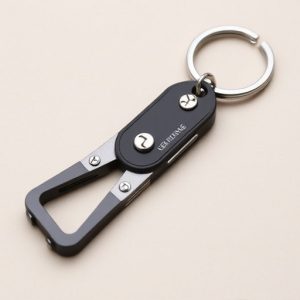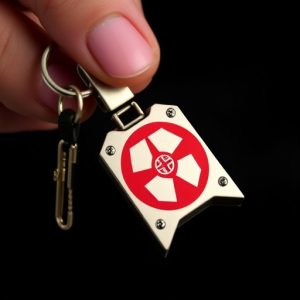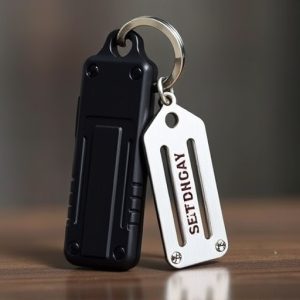Keychain Self-Defense: Legal Compliance Check for Permitted Tools
In the legal context, "keychain safety devices" are compact tools for personal safety, aid…….
In the legal context, "keychain safety devices" are compact tools for personal safety, aiding users in securing access and providing immediate defense during emergencies while adhering to public safety guidelines. These include alarms, pepper spray, or window-breaking knives, all small, portable, and attached to a keychain. Regional laws vary regarding permitted self-defense tools like pepper spray, Tasers, or stun keys; thus, it's crucial to check local definitions and stay informed state-by-state. Consumers should look for certified products with testing reports verifying force, durability, and functionality, ensuring legal integrity and promoting personal security.
In today’s world, ensuring personal safety is paramount. One innovative solution gaining traction are keychain safety devices, designed for quick self-defense. But navigating legal requirements can be a challenge. This comprehensive guide delves into the definition of a keychain safety device, explores self-defense laws and permitted tools, and provides a state-by-state legal check. We also offer tips for consumers and manufacturers to ensure compliance with regulations surrounding these compact life-savers. Discover your rights and stay protected by understanding the legal landscape of permitted self-defense keychain tools.
- Understanding Legal Definitions: What Constitutes a Keychain Safety Device?
- Self-Defense Laws and Permitted Tools
- Regional Variations: State-by-State Legal Check
- Ensuring Compliance: Tips for Consumers and Manufacturers
Understanding Legal Definitions: What Constitutes a Keychain Safety Device?
In the legal realm, a “keychain safety device” is defined as any compact tool or instrument designed to protect against unauthorized access to secured areas or personal property. These devices are often permitted self-defense keychain tools that offer users a quick and effective means of deterring potential thieves or intruders. The concept revolves around balancing personal safety with public safety, ensuring that such tools are not used in a manner that poses harm to others.
To be considered a legitimate keychain safety device, the tool must meet specific criteria. It should be small and easily portable, attached to a keychain or similar accessory, and designed for immediate use in an emergency situation. Examples include personal alarms, pepper spray, and certain types of self-defense knives or tools that can break windows or unlock doors discreetly. The key lies in their functionality as temporary measures for escape or protection without causing permanent harm or injury.
Self-Defense Laws and Permitted Tools
In many jurisdictions, self-defense is a legal right, allowing individuals to protect themselves from harm. When it comes to keychain safety devices, understanding what’s permitted as self-defense tools is crucial. Laws vary across regions, but typically, small, non-lethal weapons designed for personal protection are considered acceptable. These often include items like pepper spray, Tasers, or certain types of stun keys.
The key is to ensure the device is intended for personal safety and its use aligns with local self-defense laws. Some regions have specific regulations on the type of force that can be used in self-defense, so it’s essential to check the legal definition of “permitted self-defense keychain tools” in your area to avoid any legal complications.
Regional Variations: State-by-State Legal Check
When considering the legality of keychain safety devices, it’s crucial to remember that regulations vary greatly from one region to another. In the United States, for instance, what’s permitted as a self-defense keychain tool in one state might be strictly regulated or even illegal in another. For example, while some states allow small pepper spray devices attached to keychains, others have restrictions on the size, capacity, and accessibility of such items. Similarly, laws regarding stun guns or personal alarms also differ significantly across the nation.
Therefore, when purchasing a keychain safety device, it’s essential to conduct a state-by-state legal check. Online resources and local law enforcement agencies can be invaluable tools for this task. Staying informed about these variations ensures you’re complying with your region’s specific laws and regulations regarding permitted self-defense keychain tools.
Ensuring Compliance: Tips for Consumers and Manufacturers
Ensuring compliance with legal requirements for keychain safety devices is paramount, especially considering their potential as permitted self-defense tools. Consumers should look for products that meet specific standards set by regulatory bodies. This includes checking for certifications and testing reports that attest to the device’s effectiveness and safety. Always verify that the keychain meets the necessary criteria for force, durability, and functionality required for legal self-defense purposes.
Manufacturers play a crucial role in maintaining these standards. They must stay updated on relevant laws and regulations, implement rigorous quality control measures, and provide transparent information about their products. By adhering to guidelines and offering detailed specifications, manufacturers ensure that consumers purchase legally compliant keychain safety devices, promoting both personal security and legal integrity.
When it comes to keychain safety devices, understanding legal requirements is essential for both consumers and manufacturers. By familiarizing themselves with self-defense laws and regional variations, individuals can ensure they possess and use permitted tools responsibly. For manufacturers, adhering to these guidelines not only ensures compliance but also promotes public safety. Remember, the key to staying within legal boundaries lies in knowing what constitutes a keychain safety device and its appropriate use in different jurisdictions.


